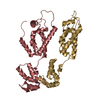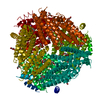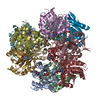[English] 日本語
 Yorodumi
Yorodumi- PDB-4usn: The structure of the immature HIV-1 capsid in intact virus partic... -
+ Open data
Open data
- Basic information
Basic information
| Entry | Database: PDB / ID: 4usn | ||||||
|---|---|---|---|---|---|---|---|
| Title | The structure of the immature HIV-1 capsid in intact virus particles at sub-nm resolution | ||||||
 Components Components | P24 | ||||||
 Keywords Keywords | VIRAL PROTEIN / RETROVIRUS / MATURATION / GAG | ||||||
| Function / homology | : / gag protein p24 N-terminal domain / viral process / Retroviral nucleocapsid Gag protein p24, C-terminal domain / Gag protein p24 C-terminal domain / Retrovirus capsid, C-terminal / Retrovirus capsid, N-terminal / viral capsid / p24 Function and homology information Function and homology information | ||||||
| Biological species |   HUMAN IMMUNODEFICIENCY VIRUS 1 HUMAN IMMUNODEFICIENCY VIRUS 1 | ||||||
| Method | ELECTRON MICROSCOPY / electron tomography / cryo EM / Resolution: 8.8 Å | ||||||
 Authors Authors | Schur, F.K.M. / Hagen, W.J.H. / Rumlova, M. / Ruml, T. / Mueller, B. / Kraeusslich, H.-G. / Briggs, J.A.G. | ||||||
 Citation Citation |  Journal: Nature / Year: 2015 Journal: Nature / Year: 2015Title: Structure of the immature HIV-1 capsid in intact virus particles at 8.8 Å resolution. Authors: Florian K M Schur / Wim J H Hagen / Michaela Rumlová / Tomáš Ruml / Barbara Müller / Hans-Georg Kräusslich / John A G Briggs /   Abstract: Human immunodeficiency virus type 1 (HIV-1) assembly proceeds in two stages. First, the 55 kilodalton viral Gag polyprotein assembles into a hexameric protein lattice at the plasma membrane of the ...Human immunodeficiency virus type 1 (HIV-1) assembly proceeds in two stages. First, the 55 kilodalton viral Gag polyprotein assembles into a hexameric protein lattice at the plasma membrane of the infected cell, inducing budding and release of an immature particle. Second, Gag is cleaved by the viral protease, leading to internal rearrangement of the virus into the mature, infectious form. Immature and mature HIV-1 particles are heterogeneous in size and morphology, preventing high-resolution analysis of their protein arrangement in situ by conventional structural biology methods. Here we apply cryo-electron tomography and sub-tomogram averaging methods to resolve the structure of the capsid lattice within intact immature HIV-1 particles at subnanometre resolution, allowing unambiguous positioning of all α-helices. The resulting model reveals tertiary and quaternary structural interactions that mediate HIV-1 assembly. Strikingly, these interactions differ from those predicted by the current model based on in vitro-assembled arrays of Gag-derived proteins from Mason-Pfizer monkey virus. To validate this difference, we solve the structure of the capsid lattice within intact immature Mason-Pfizer monkey virus particles. Comparison with the immature HIV-1 structure reveals that retroviral capsid proteins, while having conserved tertiary structures, adopt different quaternary arrangements during virus assembly. The approach demonstrated here should be applicable to determine structures of other proteins at subnanometre resolution within heterogeneous environments. | ||||||
| History |
|
- Structure visualization
Structure visualization
| Movie |
 Movie viewer Movie viewer |
|---|---|
| Structure viewer | Molecule:  Molmil Molmil Jmol/JSmol Jmol/JSmol |
- Downloads & links
Downloads & links
- Download
Download
| PDBx/mmCIF format |  4usn.cif.gz 4usn.cif.gz | 589 KB | Display |  PDBx/mmCIF format PDBx/mmCIF format |
|---|---|---|---|---|
| PDB format |  pdb4usn.ent.gz pdb4usn.ent.gz | 397.1 KB | Display |  PDB format PDB format |
| PDBx/mmJSON format |  4usn.json.gz 4usn.json.gz | Tree view |  PDBx/mmJSON format PDBx/mmJSON format | |
| Others |  Other downloads Other downloads |
-Validation report
| Summary document |  4usn_validation.pdf.gz 4usn_validation.pdf.gz | 753.7 KB | Display |  wwPDB validaton report wwPDB validaton report |
|---|---|---|---|---|
| Full document |  4usn_full_validation.pdf.gz 4usn_full_validation.pdf.gz | 804.6 KB | Display | |
| Data in XML |  4usn_validation.xml.gz 4usn_validation.xml.gz | 79.3 KB | Display | |
| Data in CIF |  4usn_validation.cif.gz 4usn_validation.cif.gz | 133.8 KB | Display | |
| Arichive directory |  https://data.pdbj.org/pub/pdb/validation_reports/us/4usn https://data.pdbj.org/pub/pdb/validation_reports/us/4usn ftp://data.pdbj.org/pub/pdb/validation_reports/us/4usn ftp://data.pdbj.org/pub/pdb/validation_reports/us/4usn | HTTPS FTP |
-Related structure data
| Related structure data |  2706MC  2707C  2708C M: map data used to model this data C: citing same article ( |
|---|---|
| Similar structure data |
- Links
Links
- Assembly
Assembly
| Deposited unit | 
|
|---|---|
| 1 | 
|
| 2 | 
|
| 3 | 
|
| 4 | 
|
| 5 | 
|
| 6 | 
|
| 7 | 
|
- Components
Components
| #1: Protein | Mass: 23427.887 Da / Num. of mol.: 18 / Fragment: IMMATURE HIV-1 CAPSID, RESIDUES 4-213 / Source method: isolated from a natural source / Source: (natural)   HUMAN IMMUNODEFICIENCY VIRUS 1 / References: UniProt: Q9IVM8 HUMAN IMMUNODEFICIENCY VIRUS 1 / References: UniProt: Q9IVM8Sequence details | ONLY PARTS OF THE CAPSID (P24) SEQUENCE ARE USED | |
|---|
-Experimental details
-Experiment
| Experiment | Method: ELECTRON MICROSCOPY |
|---|---|
| EM experiment | Aggregation state: PARTICLE / 3D reconstruction method: electron tomography |
- Sample preparation
Sample preparation
| Component | Name: INTACT HIV-1 PARTICLES TREATED WITH THE PROTEASE INHIBITOR AMPRENAVIR Type: VIRUS |
|---|---|
| Buffer solution | Name: 25MM MES PH 6.5, 150MM NACL / pH: 6.5 / Details: 25MM MES PH 6.5, 150MM NACL |
| Specimen | Embedding applied: NO / Shadowing applied: NO / Staining applied: NO / Vitrification applied: YES |
| Specimen support | Details: HOLEY CARBON |
| Vitrification | Instrument: FEI VITROBOT MARK II / Cryogen name: ETHANE Details: VITRIFICATION 1 -- CRYOGEN- ETHANE, HUMIDITY- 100, INSTRUMENT- FEI VITROBOT MARK III, METHOD- DEGASSED C-FLAT 2- 2-2C GRIDS WERE GLOW DISCHARGED FOR 30 SECONDS AT 20 MA. VIRUS SOLUTION WAS ...Details: VITRIFICATION 1 -- CRYOGEN- ETHANE, HUMIDITY- 100, INSTRUMENT- FEI VITROBOT MARK III, METHOD- DEGASSED C-FLAT 2- 2-2C GRIDS WERE GLOW DISCHARGED FOR 30 SECONDS AT 20 MA. VIRUS SOLUTION WAS DILUTED IN PBS CONTAINING 10NM COLLOIDAL GOLD. 2 UL OF THIS MIXTURE WAS APPLIED TO A GRID. BLOTTING TIME 2 SECONDS, |
- Electron microscopy imaging
Electron microscopy imaging
| Experimental equipment |  Model: Titan Krios / Image courtesy: FEI Company |
|---|---|
| Microscopy | Model: FEI TITAN KRIOS / Date: Aug 13, 2013 |
| Electron gun | Electron source:  FIELD EMISSION GUN / Accelerating voltage: 200 kV / Illumination mode: FLOOD BEAM FIELD EMISSION GUN / Accelerating voltage: 200 kV / Illumination mode: FLOOD BEAM |
| Electron lens | Mode: BRIGHT FIELD / Nominal magnification: 42000 X / Nominal defocus max: 4000 nm / Nominal defocus min: 1200 nm / Cs: 2.7 mm |
| Specimen holder | Tilt angle max: 60 ° / Tilt angle min: -45 ° |
| Image recording | Electron dose: 40 e/Å2 / Film or detector model: GATAN MULTISCAN |
| Radiation wavelength | Relative weight: 1 |
- Processing
Processing
| EM software |
| |||||||||||||||||||||
|---|---|---|---|---|---|---|---|---|---|---|---|---|---|---|---|---|---|---|---|---|---|---|
| CTF correction | Details: PHASE FLIPPING OF INDIVIDUAL TILTS | |||||||||||||||||||||
| Symmetry | Point symmetry: C6 (6 fold cyclic) | |||||||||||||||||||||
| 3D reconstruction | Resolution: 8.8 Å / Nominal pixel size: 2.025 Å / Actual pixel size: 2.025 Å Details: SUBMISSION BASED ON EXPERIMENTAL DATA FROM EMDB EMD -2706. (DEPOSITION ID: 12684). Symmetry type: POINT | |||||||||||||||||||||
| Atomic model building | Protocol: FLEXIBLE FIT / Space: REAL / Details: METHOD--FLEXIBLE REFINEMENT PROTOCOL--X-RAY,NMR | |||||||||||||||||||||
| Atomic model building |
| |||||||||||||||||||||
| Refinement | Highest resolution: 8.8 Å | |||||||||||||||||||||
| Refinement step | Cycle: LAST / Highest resolution: 8.8 Å
|
 Movie
Movie Controller
Controller








 PDBj
PDBj


